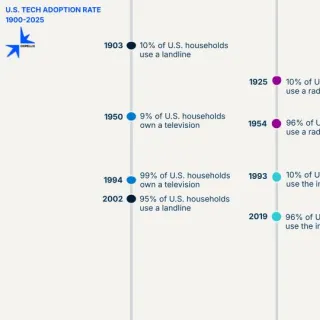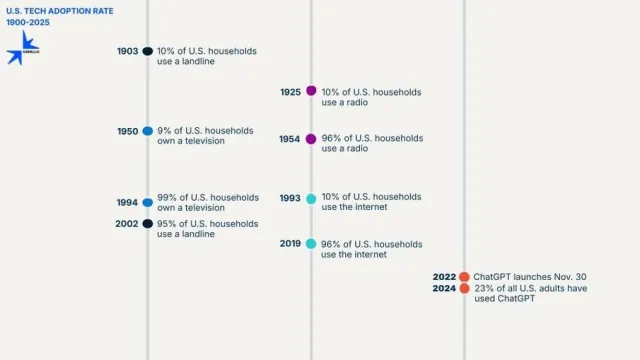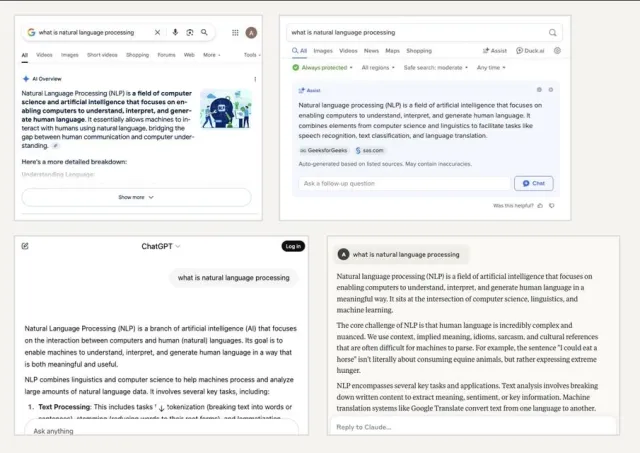

Is AI stealing my website traffic? If so, why?
Just how quickly is AI changing communication norms?
We used to have more time to understand and adapt to new technologies that fundamentally shifted how we shared information. It took just under a century for 95% of U.S. households to use a landline. 100 years collapsed to about 30 years each for 96% adoption of the radio, television, and internet in U.S. households.
Now we have large language models (LLMs) that power AI chatbots. ChatGPT, the first user-friendly chatbot, was introduced in November 2022. Within 16 months, nearly 1 in 4 of all U.S. consumers had used it. As of March of this year, per an Elon University survey, more than 50% of all U.S. adults had used any LLM (Gemini, Claude.ai, etc.).
Here’s a visualization of this technology adoption race over the last 125 years, from slowest to fastest:

As Bob Dylan sang in another context: Oh the times, they are a-changin’.
Why is it so hard to get organic traffic now?
Once upon a time, I used sources like my elders and Encyclopedia Britannica on CD-ROM for research. I remember how much time it could take to answer questions like “When was television invented?” or “What were the causes of the Civil War?” By temperament and training I look for original sources. But search tool design and convenience discourages taking that step.
Voice-activated search, the ability to ask AI tools questions instead of using key words, and the presentation of search results discourage users from clicking through to original sources–your content.
Let’s take a look at the role of each of these changes affecting your website traffic.
Platform Preference: From Typing to Talking
More people are using smart voice assistants (SVAs) like Alexa and Siri to search for information, and they’re doing so away from a digital device—in the kitchen, at the cookout table, in the car. According to Deloitte’s 2018 digital trends survey, 19% of U.S. consumers used an SVA daily for simple tasks, like searching for information. Within 6 years, that number shot up to 81%, per TELUS Digital Solutions.
The entire online search experience has shifted from a visual to an auditory one. This decreases the chance of direct interaction with and exploration of a website’s resources. “Alexa, show me cute penguin videos” just doesn’t work. (Yet.)
From Keywords to Questions: Natural Language Processing (NLP)
NLP is how computers interpret and respond to human language. Thanks to NLP, informational content is particularly easy for AI assistants to summarize and reproduce—and for Google, unlikely to disrupt their ad revenue model. (Keeping you on Google Search incentivizes content owners to spend money on Google ads and search placement.)
From animal care to civil rights, many nonprofits focus on content production that educates readers about key issues and provides guidance on managing them. The more informational your content is overall–as opposed to selling products, for example–the more of your content can be integrated into an AI overview.
Search Engine Results Pages: Buried Sources
Tech giants like Google are rolling out AI summaries at the top of search results pages, pushing source websites down the page, while newer competitors like Claude.ai, Perplexity, ChatGPT, require extra clicks to the sources. Some of these tools display the names of content sources. Some display only link indicators. And occasionally, there are no cited sources at all.
Look at the results for the search query "What is natural language processing?" below. It’s easiest to find the sources cited in DuckDuckGo (top right), harder in Google Search, and not possible in ChatGPT or Claude.ai without specifically asking for them.

Even if your content is the first source in the list, on mobile devices, the user has to scroll to find it. More scrolling means less visibility and fewer clicks. (When was the last time you clicked on the 10th or 12th search result?)
Large-scale studies in Q4 2024 by Advanced Web Studies, in March 2025 by SEMrush, and in April 2025 by Ahrefs confirmed this hypothesis: AI Overviews have decreased click-through rates by as much -35% from organic search.
Note: Some product developers and researchers see AI results boosting click-through rates. Google’s Head of Search, Elizabeth Reid, claimed in April that AI Overviews gets users to search more and that it “opens up new opportunities for websites, for creators, for publishers to access. And they get higher-quality clicks.” But Google, of course, is trying to hold onto its position as the most-used search engine in the U.S.
Next Steps for Nonprofits
It’s tempting to focus on tactics for helping AI tools find and prioritize your content. But the causes and pace of technological change suggest we don’t have enough data to know which ones will be durable (as much as any digital tactic can be).
Yet the trends affecting user search behavior show it’s time to revisit organization-wide goals for connecting with key audiences.
Questions to guide your strategy development include:
- What does organizational success look like?
- What do we offer (ideas, resources, events, other) that no one else does?
- Fill in the blanks: We provide _________, unlike our peers, who ___________.
- What does measurable, impactful audience engagement look like?
- What do we want audiences to do with our content, regardless of where they find it?
- What could a hybrid face-to-face and digital strategy look like?

Expect changing your strategic goals to be slow. It’s like turning a ferry instead of a skiff: planning and incremental shifts keep passengers upright and focused on the destination. No need to fear the swirling waters below: with dedicated time for planning, your organization can weather this change.

